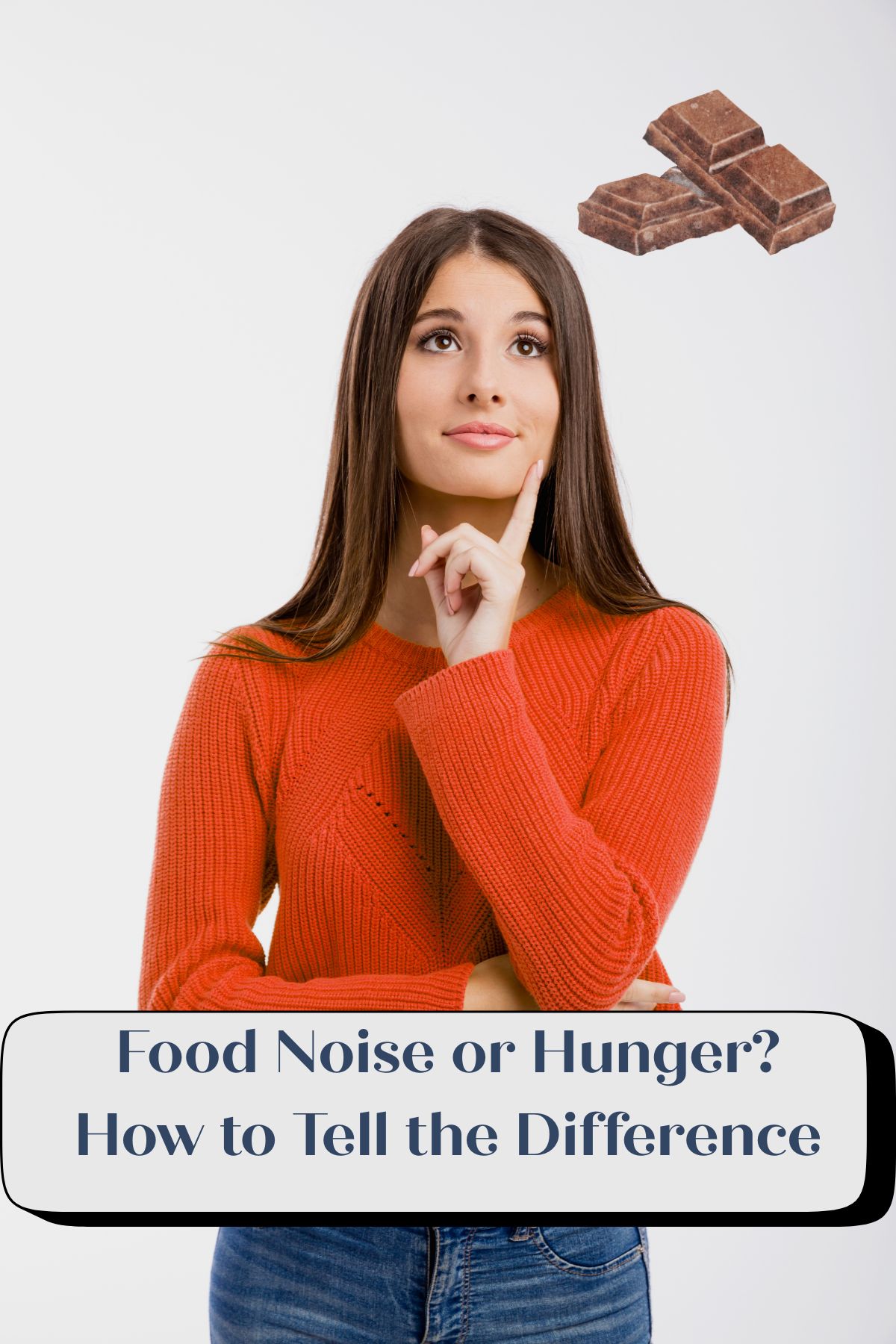This article explains the difference between food noise and true hunger, why food noise can persist even on medications like Mounjaro, and how to identify and manage persistent cravings.
I’m more than seven months into Mounjaro and have lost 30 pounds. My hunger is nothing like it used to be. I can go all day without snacking, I don’t eat junk food, and my daytime eating feels completely under control.
But at night after dinner, I always want chocolate. Not a binge, not a whole bar, just enough to “have it.” Sometimes I don’t even enjoy the taste, but my brain still demands it.

This is the difference between hunger and food noise. And if you’ve ever been told that eating enough protein and fiber will make the cravings disappear, I’m here to tell you that this is not the whole story.
Jump to:
- What Hunger Really Is
- What Food Noise Really Is
- Why GLP-1s Address One More Than the Other
- The Social Media Problem
- My Fear For After Mounjaro
- Why “Just Eat Protein and Fiber” Isn’t Enough
- Why Some People Stay on GLP-1s Long Term
- GLP-1 Aftercare: Life Beyond the Medication
- The Science of Why Habits Stick
- How to Start Working Food Noise Out of Your Life
- Faqs About Food Noise and GLP-1s
- I Think You Might Like These Too
What Hunger Really Is
Hunger is a physical signal from your body that it needs fuel. It’s driven by hormones like ghrelin, which rises before meals, and leptin, which decreases to allow appetite. It’s also influenced by blood sugar changes that prompt your brain to ask for quick energy, and by physical cues like stomach growling, emptiness, low energy, and irritability.
When you eat enough, hunger shuts down. Your body gets the fuel it needs and moves on.
What Food Noise Really Is
Food noise is mental chatter about food when your body doesn’t actually need it. It is powered by habits like always having dessert after dinner, emotional eating for comfort or stress relief, reward pathways that light up when you eat sugar, fat, or salt, and environmental triggers like watching TV, smelling food, or even just walking into the kitchen.
You can be completely full and still have food noise. It lives in your head, not your stomach.
Why GLP-1s Address One More Than the Other
GLP-1 medications like Mounjaro, Ozempic, and Wegovy are designed to tackle hunger. They slow digestion so you feel full longer, reduce ghrelin so you have fewer hunger spikes, and strengthen satiety signals to the brain.
But they can’t erase decades of learned food habits. If you have always had something sweet after dinner, your brain still expects it, even if your stomach is already full.
The Social Media Problem
Social media can be a sneaky trigger for food noise, especially when you’re scrolling through videos of people on Mounjaro sharing “What I eat in a day.” Many of these meals are fast food, presented in perfectly lit shots with sizzling sounds and tempting close-ups. The weight still comes off for them, but not because they are eating healthier.
The truth is, these videos are designed to grab attention and keep you watching. For someone dealing with food noise, they can act like a switch, creating cravings that weren’t there a minute ago. It’s eating for pleasure, entertainment, or the sake of content, not because the body needs fuel.
For me, it’s different. I crave vegetables and lean meats. I rarely eat fast food because I didn’t do it before Mounjaro either. I’ve never been big on snacks, and too much sugar makes me feel unwell. My snacks have always been modest, a little chocolate here and there, some carbs, and if I was really upset, my comfort food was bread and lard. Don't laugh. I have German roots in me and schmaltz is a way of life.
If you notice social media content making your cravings worse, try curating your feed. Unfollow accounts that constantly post food, limit scrolling during the times you tend to snack, and replace some of that visual temptation with content unrelated to eating.
My Fear For After Mounjaro
Here’s the part that keeps me up at night: what happens when I stop Mounjaro? I’m terrified of going back to the same habits that led to insulin resistance and weight gain in the first place. I don’t want to end up with type 2 diabetes because I slipped back into old patterns.
Today was a wake-up call. I ate chocolate after dinner and realized I wasn’t even enjoying the sweet taste, yet I still ate it. That’s not hunger. That’s a habit. And habits can be stubborn.
Why “Just Eat Protein and Fiber” Isn’t Enough
You’ve probably heard the advice from life coaches, dietitians, bodybuilders, and influencers: “If you eat enough protein and fiber, you won’t want anything else.”
It’s an oversimplification. Protein and fiber help with satiety, but they address only one part of the equation, physical hunger. They do not address the mental side of eating, the habits, emotional triggers, and reward pathways that drive food noise.
More on this subject: The Guilt of Getting Better on GLP‑1s
When people give this advice without understanding the bigger picture, it can come across as judgmental. It assumes that anyone who still craves food is lacking willpower, doesn’t care, or isn’t trying hard enough. The reality is that most people with obesity have already tried everything.
Obesity is a complex, multilayered disease. It is influenced by biology, environment, psychology, and even trauma. It is not simply about “trying harder.” And oversimplified advice doesn’t just fail to help, it adds to the shame and stigma people living with obesity already face.
Why Some People Stay on GLP-1s Long Term
Food noise is one of the biggest reasons people may need to stay on these medications beyond the initial weight loss phase.
It’s not always about hunger coming back. For many, it’s the mental cravings, the automatic patterns, and the emotional triggers that return once the medication is stopped. If those aren’t addressed during treatment, going off the medication can mean going straight back into the same cycles that caused weight gain in the first place.
For some, long-term or even indefinite use isn’t about “not trying hard enough,” it’s about ongoing support for a chronic, relapsing condition.
Some other reasons people might stay longer on GLP-1s are chronic inflammation, insulin resistance and prediabetes, cardiovascular risk reduction, etc.
Read more: New Year’s Resolutions Are Designed To Fail
GLP-1 Aftercare: Life Beyond the Medication
One of the most important but least-discussed parts of GLP-1 treatment is planning for what comes after. If the medication has helped you reduce hunger but not fully address food noise, stopping it can feel like pulling away the safety net.
Aftercare should start while you are still on the medication. This can mean building sustainable eating patterns that are not dependent on the drug, practicing portion control without the extreme appetite suppression, and identifying emotional triggers for eating so they can be addressed directly.
Some people will decide to stay on a maintenance dose long term, while others will taper off completely. Either way, success depends on having strategies in place for managing food noise, because hunger will eventually return to some degree.
Read this: When Your Body Says ‘No Thanks’ to Exercise
The Science of Why Habits Stick
When you eat something that tastes good, especially foods high in sugar, salt, or fat, your brain releases dopamine. Over time, your brain learns to expect that reward in certain situations, times of day, or emotional states.
That’s why dessert after dinner feels automatic. It’s not just about taste, it’s about the ritual and the chemical payoff.
How to Start Working Food Noise Out of Your Life
If I’m going to succeed after Mounjaro, I can’t rely on the medication alone. I have to work on the mental side now. Here’s how I’m starting:
- Identify patterns. My chocolate cravings happen at night, after dinner, when I sit down to watch TV.
- Break the link. If I want chocolate, I get up and do something else first, like take a walk, clean the kitchen, or fold laundry.
- Delay the decision. I wait 20 minutes before eating it. Sometimes the craving fades.
- Portion intentionally. If I’m going to have chocolate, I decide the amount beforehand.
- Experiment with swaps. A small bowl of berries or Greek yogurt can satisfy without triggering the same sugar cycle.
Faqs About Food Noise and GLP-1s
In many people, yes. GLP-1 medications like Mounjaro can reduce brain activity in areas linked to cravings and reward, making food less mentally intrusive. But they’re more effective at reducing physical hunger than breaking long-standing habits or emotional eating triggers.
Persistent food noise can be linked to learned behaviors, emotional eating, or environmental triggers like social media and certain routines. These cues aren’t eliminated by medication alone and often need separate strategies to address.
For some, the pleasure and convenience of certain foods are deeply ingrained habits. Even with less hunger and reduced cravings, they may still choose these foods out of routine, taste preference, or for social and emotional reasons.
It’s possible. If habits and triggers aren’t addressed while on medication, food noise can return when the drug is discontinued, sometimes along with increased hunger. Planning an “aftercare” strategy can help maintain progress.
Research is ongoing. There’s early evidence that GLP-1s may help reduce cravings for substances like alcohol, nicotine, and even compulsive behaviors, but these effects vary and are not guaranteed.
Hunger is physical. Food noise is mental. GLP-1s make hunger a whisper, but food noise can still shout.
If you’re on a GLP-1 and you still find yourself eating something you didn’t actually want or enjoy, it’s not weakness. It’s your brain running a well-practiced program.
The real success isn’t just in losing weight while on the medication. It’s in rewriting that program so that when the medication stops, the old habits don’t come rushing back.
I Think You Might Like These Too
- MHT and Mounjaro: Finding Balance in Midlife
- How Mounjaro Changed The Way I See Food
- GLP-1 Life
- GLP-1 Weight Loss: Why You Should Wait to Buy New Clothes






Leave a Reply